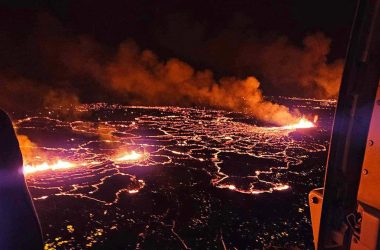The Tonga volcano known as Hunga Tonga-Hunga Haʻapai erupted in January, sending a massive plume of ash, gases, and water high into the atmosphere, even reaching the mesosphere. This volcanic plume reached a height of 57.5 kilometers at its peak, making it the highest recorded plume from a volcano. The eruption occurred twice within a short period, once at 0430 UTC and again at 0450 UTC on January 15th. Despite its remote location in the Pacific Ocean, the eruption caused significant damage, leading to the loss of six lives. The eruption was so powerful that loud booms were heard as far away as New Zealand and Australia. Scientists, such as Simon Proud from the University of Oxford, considered the remote location fortunate as it prevented more devastating consequences if the eruption occurred in a populated area.
A view of the Tonga eruption, 10 minutes after it started, taken by Japan’s Himawari-8 satellite
Simon Proud / Uni Oxford, RALSpace NCEO / Japan Meteorological Agency
To determine the exact height of the volcanic plume, scientists faced challenges typical methods failed to overcome. Usually, the temperature of a volcanic cloud and the surrounding clouds is measured to calculate the plume’s height. However, the plume from the Hunga Tonga-Hunga Haʻapai eruption was too high for this approach. Instead, Proud and his colleagues used satellite data and the parallax effect, where the location of objects appears to shift based on viewing angle, to accurately determine the height of the plume. By utilizing images from multiple weather satellites with different angles, scientists could obtain precise estimates of the plume’s height.
These findings confirm a NASA analysis published in February, which estimated the eruption’s peak height at 58 kilometers using only two satellites. Proud’s assessment, however, incorporated data from additional satellites, making it more reliable. The eruption of a volcano into the mesosphere is exceptionally rare, and this confirmation of occurrence is a significant scientific achievement. It is worth noting that the last eruption of a similar magnitude was Krakatoa in 1883.
This new method of measuring volcano plume height could also have applications in assessing the heights of growing storm clouds and estimating their severity, according to Proud.












